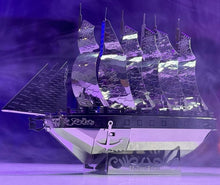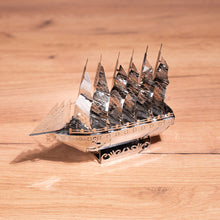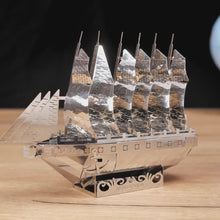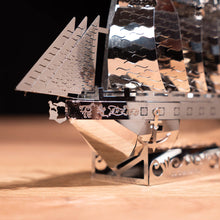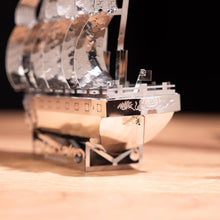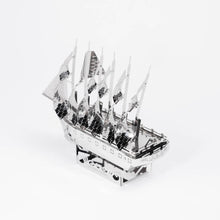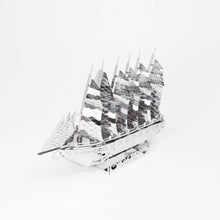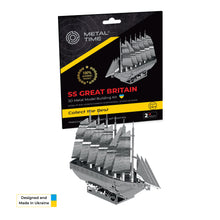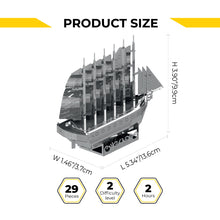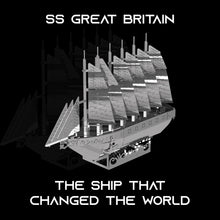
Specifications
| Quantity of parts, pcs | 29 |
| Difficulty level, from 1 to 8 | 2 |
| Hours to assemble (average) | 2 |
| Model size (cm) | 13.6×3.7×9.9 |
| Model size (inch) | 5.34×1.46×3.90 |
| Historically accurate model for self-assembly |
| Made in Ukraine |
Prototype history
Great Britain is a former passenger steamship that was advanced for her time. She was the largest passenger ship in the world from 1845 to 1854. She was designed by Isambard Kingdom Brunel (1806–1859), for the Great Western Steamship Company's transatlantic service between Bristol and New York City.
While other ships had been built of iron or equipped with a screw propeller, Great Britain was the first to combine these features in a large ocean-going ship. She was the first iron steamer to cross the Atlantic Ocean, which she did in 1845, in 14 days.
When launched in 1843, Great Britain was by far the largest vessel afloat. But her protracted construction time of six years (1839–1845) and high cost had left her owners in a difficult financial position, and they were forced out of business in 1846, having spent all their remaining funds refloating the ship after she ran aground at Dundrum Bay in County Down near Newcastle in what is now Northern Ireland, after a navigation error. In 1852 she was sold for salvage and repaired. Great Britain later carried thousands of emigrants to Australia from 1852 until being converted to all-sail in 1881. Three years later, she was retired to the Falkland Islands, where she was used as a warehouse, quarantine ship and coal hulk until she was scuttled in 1937, 98 years after being laid down.


Features, benefits
The launching or, more accurately, the float-out took place on 19 July 1843. Conditions were generally favourable and diarists recorded that, after a dull start, the weather brightened with only a few intermittent showers. The atmosphere of the day can best be gauged from a report the following day in The Bristol Mirror.
Great Britain's builders recognised a number of advantages of iron over the traditional wooden hull. Wood was becoming more expensive, while iron was getting cheaper. Iron hulls were not subject to dry rot or woodworm, and they were also lighter in weight and less bulky. The chief advantage of the iron hull was its much greater structural strength. The practical limit on the length of a wooden-hulled ship is about 300 feet (91 m), after which hogging—the flexing of the hull as waves pass beneath it—becomes too great. Iron hulls are far less subject to hogging so the potential size of an iron-hulled ship is much greater. The ship's designers, led by Brunel, were initially cautious in the adaptation of their plans to iron-hulled technology. With each successive draft however, the ship grew ever larger and bolder in conception. By the fifth draft, the vessel had grown to 3,400 tons, over 1,000 tons larger than any ship then in existence.


All parts are separated and connected with light finger pressure, which eliminates possible cuts or pricks during the assembly process.
The Metal Time kits comprises small parts that, under particular conditions, may be hazardous to children under the age of 14 years. If children are to carry out the model assembly, parents' supervision should be ensured.
14 languages User's guides will lead you through assembling process. In coming up with design for creative people, there is no borderline between imagination and reality.
Models are made up of many, small parts, which may be dangerous to children under 14 years old. The assembly of the model by children under 14 should be carried out under the supervision of parents. Models research and assembly advance technical creativity skills inspire science and technology history research.
Models of Metal Time are active leisure and superb gifts, interior embellishments, installation elements, models and showcase stands.
To make them gatherable and exchangeable, each of our models is assigned a unique serial number. The Metal Time Owners' Club is a group of people who are zealous about designing.
The loyalty program of Metal Time presents owners of our construction sets with pleasant surprises. Our models do not require glue or adhesive. Each part snaps off the sheet, then firmly snaps together.











